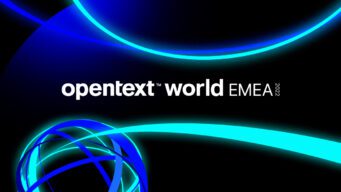The new EP4 release for our ecosystem solutions is focused on enhancements and additional functionality that supports our customers using our applications and streamlines cloud deployment and management.
The ecosystem covers four key partnerships within OpenText™—SAP®, Microsoft®, Oracle®, and Salesforce®. There is no EP4 release for the xECM for Oracle, that product received a comprehensive update as part of EP3.
The defining mantra of OpenText ecosystem solutions has always been to elevate the usage of content and extend the core benefits of ECM into an organization’s lead applications. The goal is to provide content in the context of relevant business processes, such as procure-to-pay or order-to-cash, and make it available to users in the interface they’re most comfortable working with.
Recognizing that the Enterprise Content Management (ECM) platform is not the lead application in this model is key, as is the idea that the correct and compliant storage of content attached to these processes is every bit as relevant as storing the unstructured content generated every day within an organization.
With this in mind we focus on two areas of the enterprise—the digital workplace and the digital business.
The digital business is comprehensively supported by our ecosystem solutions—with deep integration into not just the technology but the use of technology such as Real Estate Management, Asset Management, Health And Safety Management, Accounts Payable, and many others.
The digital workplace has always been covered by integration into UI standards such as SAP Fiori®, Salesforce Lightning and MS Office. And, to augment this we are announcing a new solution as part of the EP4 release—OpenText Extended ECM for Microsoft Office 365®. Office 365 is the standard for the creation of content by knowledge workers. And, with our new solution, we are comprehensively and seamlessly providing ECM capabilities to the tip of the spear—the creation point of content. By enabling Office users to save their content directly into ECM, the creation of the content can become the start of the process, promoting collaboration to provide additional value and improve decision-making capabilities. My colleague Chris Sargent has written a great blog detailing the value of our Extended ECM for Office 365 solution.
Whats new for the Ecosystem in Ep4 from OpenText
OpenText Extended ECM Platform
Everything released at the platform level cascades into the different Extended ECM solutions such as SAP, SuccessFactors®, Government, Engineering, Salesforce, and newly released Office 365.
To enable the Extended ECM platform for the cloud in EP4, separate workspaces have been created for key admin functions, separating the business administration from the system administration. This allows a greater granularity in permissions and reduces the access requirement for day-to-day and week-to-week business admin from the system administrators.
The second major new feature for the Extended ECM platform is around further refinement of the Smart UI. As the Smart UI continues to evolve in terms of flexibility and functionality, we have added the ability to start and interact with workflows with a quick action to start a workflow and smart forms that are generated automatically based on the workflow definition. Workflow’s can consist of one or many documents in the payload, allowing for bulk approval and status changes to content.
OpenText Extended ECM for Microsoft Office 365
Extended ECM for Microsoft Office 365 is a new offering to provide ECM support and integration directly into Office 365, bridging the gap between content creation and business processes. With Extended ECM for Microsoft Office 365 you can now link the creation and collaboration capabilities of Office 365 into the Enterprise ecosystem of SAP, Oracle, Salesforce, Microsoft Dynamics, and many others.

Users become more efficient and processes become smoother when the very creation of content is intrinsically and intuitively linked into a business workspace. The collaboration and creation capabilities of Office 365 are all now underpinned by an enterprise CMS platform.
OpenText Extended ECM for SuccessFactors
For OpenText Extended ECM For SuccessFactors, two major features have been improved based on industry needs and feedback from our customers. First, we have better synchronization between SuccessFactors and Extended ECM, ensuring that new employee workspaces and changes to employee status are reflected faster and in a more efficient manner.
When producing HR letters, we have now added event-driven document creation. Documents can now be automatically created based on events in SuccessFactors without manual input. If an employee status change requires an HR letter to be created and delivered, that process can now be automated fully.
OpenText Extended ECM for SAP
OpenText Extended ECM for SAP gains some improvements to our support for the SAP Fiori interfaces. A new feature has provided business workspaces, where the user may find additional information of relevance. We are refining our integration’s to SAP applications by leveraging the CMIS interfaces to support a more open standards approach.
OpenText Extended ECM for Government
In EP4 for OpenText Extended ECM for Government, we have added a new user interface mode that supports accessibility requirements, ensuring that key public sector working regulations are met and supporting inclusivity of all users.
OpenText Extended ECM for Engineering
Most of the new capabilities for OpenText Extended ECM for Engineering were launched in the 16.3 version last year. This version includes some notable enhancements to key capabilities.
For this release, new capabilities have been added to the smart UI to make working in engineering projects more intuitive. Users can now directly open and edit CAD drawings in their native authoring application (e.g. AutoDesk or Solidworks). This supports engineers in their daily work as it further enhances the integration between Extended ECM for Engineering as single source of engineering truth and the native authoring application world on engineer’s desktop.
Another new feature is an out-of-the-box report that can be configured (not coded) to show the completion status of all documents in the different process flow states. With the numbers of documents in an engineering project potentially reaching the hundred of thousands, a report that showcases documents in each stage can be of great benefit in identifying bottlenecks and potential project delays, as well as help streamlining processes.
Finally, with the EP4 release migrating documents into the platform, as well as migrating has been made easier with an integrated bulk import capability in the smart UI, as well as transmission of documents using the Secure MFT application.
SAP DAM
Digital Asset Management (DAM) is a key requirement for organizations looking to deliver or enhance an omni-channel customer journey. The quality and consistency of the digital assets is one key way to make your products stand out from the crowd.
SAP DAM is the recognized market leader in this space, offering fully comprehensive asset management as well as new features for collaboration with the digital asset ecosystem such as design and digital agencies.
With EP4 for SAP DAM we have added a new capability called Digital Hub. This feature allows digital asset managers and brand managers to create and manage the process of collaboration with external parties and invite those parties to access certain areas of the DAM solution. This extends DAM further into the creative and delivery parts of the omni-channel ecosystem and controls the collaboration between third parties and your organization.
DAM 16.4 includes UI enhancements for SAP Hybris applications (including support for the latest versions) related to how Hybris users find and apply assets for ecommerce purposes. This version also supports SAP Hybris C4C (Cloud for customer) integration, allowing all assets generated during a customer engagement to be presented alongside the customer record.




